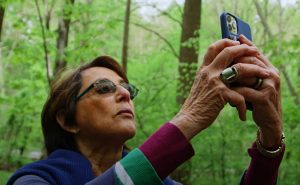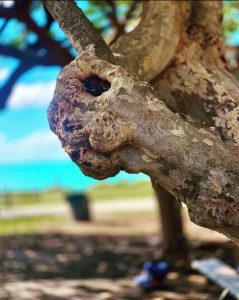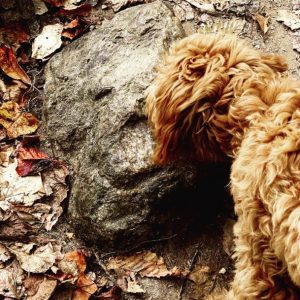Johns Hopkins UniversityEst. 1876
America’s First Research University
Pat Bernstein had walked the wooded trail near her home hundreds of times. But her first hike on the same path after a successful surgery at the Johns Hopkins Department of Neurosurgery to remove a benign meningioma tumor provided a totally new experience.

“After months of recovery, I passed the tree set by the entry to a nearby trail and was literally frozen in front of it. Tears streamed from my eyes. To me, that tree was putting its arms out and welcoming me back,” she remembers. “Not 10 feet past there was a root wrapped around the base of another tree that, for me, became a snake pointing towards the direction of the trail. For the first time, I began to recognize alternative images that nature creates on trees, rocks, and mud piles and photographed them. That became my passion for the next nine years.”
Photographs of her sightings using the neurological instinct, known as pareidolia (pronounced par-i-DOH-lee-a), were soon on exhibit at the American Visionary Art Museum in Baltimore. Bernstein began giving presentations on pareidolia to different groups, noting that their responses had value for therapeutic applications. Though the Bernstein family has a long history of dedicated support across the Johns Hopkins, this sparked Bernstein’s interest in exploring new avenues for using the phenomenon that resulted in her funding new, interdisciplinary research by Hopkins faculty.

“Turning on this instinct gives individuals exciting ways to observe things from different perspectives, and it offers opportunities to use responses as tools for future research. That’s what is exciting to me,” Bernstein says.
Though it took Bernstein by surprise after surgery, pareidolia is something all people have, explains Susan Magsamen, who graduated from Hopkins with a master’s in advanced studies in 1987. Magsamen is the executive director of the International Arts and Mind Lab at the Petersen Brain Science Institute: Center for Applied Neuroaesthetics (IAM Lab) at Johns Hopkins Medicine. Pareidolia occurs in visual perspective as well as auditory processing — like seeing a face in a cloud or hearing singing coming from a babbling brook. And though neuroscientists have some sense of where pareidolia happens in the brain, not much is understood about the phenomenon. Magsamen says researchers do know it’s an evolutionary skill that would have been valuable in identifying faces and other threats in the natural world.
“Pat gained this skill, and we don’t know why. We know so little about the brain. It’s sort of a giant patchwork quilt,” she says, adding while neurosurgeons understand where senses like vision, smell, and taste are housed, significantly less is known about the location of creativity, the arts, and aesthetic experiences.

Pareidolia is currently employed as a diagnostic tool for schizophrenia, Lewy body dementia, and other diseases. But fueled by Bernstein’s gift, Hopkins researchers are now working to expand the understanding and applications of the phenomenon. On the Homewood campus, cognitive scientists are conducting neuro-biological research into pareidolia to understand the brain mechanisms behind it.
“Scientists studying the brain basis of conscious perception have always focused on points of transition from background neural processing to cognitive awareness,” says Ed Connor, director of the Krieger Mind/Brain Institute at Homewood. “Pareidolia has never before been studied in that way. But the point at which a face or body pops into existence after we have stared for seconds or minutes at a tree or rock — that is arguably the subtlest shift we experience between non-awareness and awareness.”
The Connor Lab has begun experiments to measure how neural activity in the brain changes at that moment of pareidolic transition.
“The neural activity pattern that solidifies at that moment is the basis of visual consciousness,” Connor says.

At the IAM Lab, Magsamen’s team is bringing together experts to explore other proactive applications, including perception switching and its impact on learning, particularly around the ideas of resiliency and neural plasticity, or the ability of neural networks in the brain to change.
“We think pareidolia may enhance focus, creativity, and innovation because you’re seeing things in a different way. If this turns out to be the case, building pareidolia skills could be very useful in helping to solve problems in many areas of society,” Magsamen says. “Often we underrate different ways of interpretation or unique perceptions. Think about all the problems that you could address by having better ability to interpret ideas and learning how to communicate and collaborate more effectively. Could something as simple as pareidolia be a tool that could help do that?”
Bernstein is now concentrating on introducing pareidolia applications in the fields of nature, education, therapeutics, and medicine. She’s hopeful Hopkins research successfully enables exploration of new paths with positive outcomes.
“We’re introducing a new way to think of therapy, activities, and experiences,” she says. “This whole concept opens your mind, and the beauty is it always produces a smile. It also instills in people an instinct that they were previously unaware of, and they can walk away being able to enhance experiences for the rest of their lives.”
Topics: Friends of Johns Hopkins Medicine, Neurology, Fuel Discovery